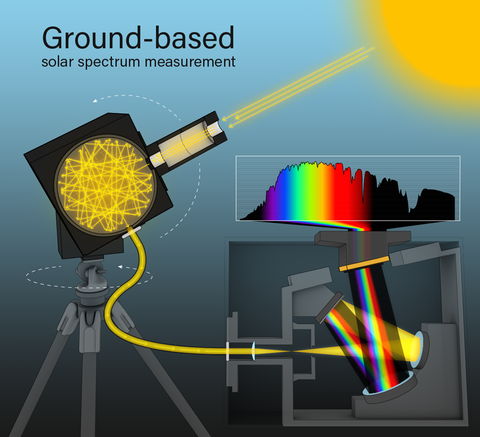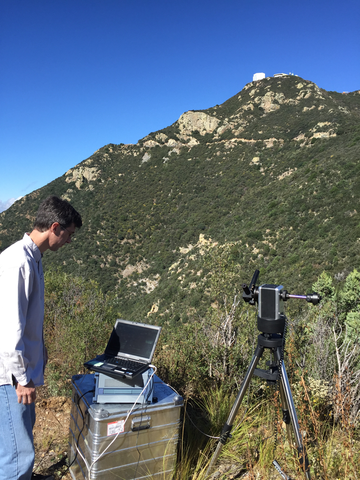It may seem hard to believe, but we still don't know nearly enough about sunlight. Although people have been splitting the sun's rays into a spectrum and measuring the results for hundreds of years, and satellites have been orbiting the Earth for decades, there remains a nagging uncertainty about the exact spectral composition* of sunshine just before it enters the atmosphere.
That poses a serious problem for climate modelers who need to input a very precise top-of-the-atmosphere spectrum into their calculations in order to produce accurate climate projections. It is also important to applications in solar energy, materials aging, solar physics, weather, and health. Now NIST has initiated an exploratory project that may help solve that problem.
Taking spectral measurements from space is challenging. Satellite sensors are calibrated on the ground, then subjected to the rigors of launch, and inevitably degraded by solar radiation. (Maintaining calibration in orbit is a very active area of research, as discussed below.) But scientists have amassed a substantial record over more than 20 years of observations. Satellite data, plus those from space shuttle missions, high-altitude aircraft, rocket soundings, ground-based solar telescopes, and modeled spectral irradiance, are combined into the standard solar spectrum published by ASTM International, a standards organization formerly known as the American Society for Testing and Materials.

Woodward and colleagues are pursuing that goal with an alternative method: making "top-of-the-atmosphere" measurements from the ground. This paradoxical activity involves using a spectrometer to follow the sun as it climbs to zenith and then descends. At each point in its journey, the sun is at a different angle, and therefore sunlight passes through a different amount of air with corresponding incremental changes in its spectrum. Those changes are recorded over an entire day. The data can then be analyzed using proven methods to extrapolate what the spectrum would be if there were no intervening atmosphere.
To make those measurements, the NIST team employs a specially designed ground-based instrument suite that combines a highly accurate, fully characterized spectrometer carefully calibrated against NIST standards, fitted with a custom light-collection system. "We've tested the spectrometer over a number of years and have found it to be extremely stable," Woodward said. "So that's what prompted us to think about using it for this project."
Detailed characterization of the spectrometer for stray light, nonlinearity, and spectral response, as well as calibration against NIST standards, allow measurements of the near-infrared and visible spectral solar irradiance at the instrument's entrance aperture to better than 0.5 % except in certain wavelength bands that are largely absorbed by the atmosphere.

The scientists have acquired multiple datasets atop a building on NIST's Gaithersburg, Md., campus. Those data are self-consistent. Now they have moved the same instrument to Mt. Hopkins, Ariz., to see how it performs there.
"We want to try at least two different locations with very different air over them so that we can see if we get the same answer," Woodward said. "Here in Gaithersburg we're not very far above sea level and it's relatively humid. But at Mt. Hopkins you're up at 7000 feet and the air is very dry. If we find that we get the same readings in both places, we can be confident that this method can provide a reliable spectral standard for climate models and other applications."
Oddly, the initial motivation for the solar spectrum work was moonlight. Woodward and PML colleagues Keith Lykke and Claire Cramer are involved in an extended effort to measure the lunar spectral reflectance – the ratio of moonlight to the amount of sunlight that falls on the lunar surface at each point in the spectrum.
As noted above, Earth-observing satellites need reliable in-orbit calibrations to track the degradation of their sensors. This is typically done by measuring the light from fixed points on the Earth – such as Antarctica or near-changeless deserts – as references. The problem with that method is that the light received by the orbiting satellite has been through the atmosphere twice, which introduces substantial uncertainties.
But there is no air between a satellite and the moon. So the moon could be used for absolute calibration – if the reflectance were well known.
"The lunar measurements are being taken at Mt. Hopkins," Woodward said, "and it was in that context that we realized that the uncertainties in the solar spectrum were larger than what we needed."
* Solar irradiance (the light energy incident on an area) across a spectrum of wavelengths. It is typically expressed in watts per square meter in a nanometer bandwidth per nanometer at the wavelength of interest.

